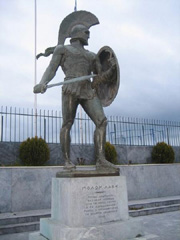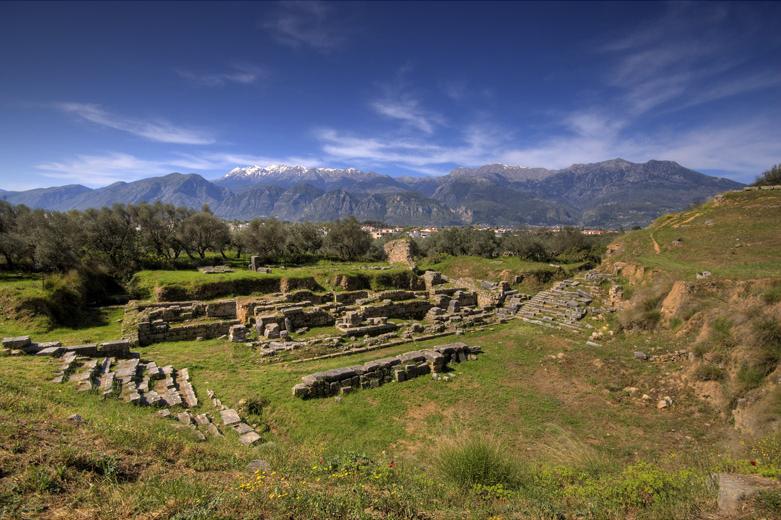SPARTA
Is the capital of the prefecture. A simple town built in the Evrotas river valley, in the same site where the ancient city stood. The plain of Lakonia spreads out around Sparta, green and cool. A few kilometers distant is the ascent for Taigetos. Snowy peaks and precipitous rock. Plateaus and ravines. Olive groves on the gentler slopes. Porlars, willows and plane trees line the banks of the Evrotas. Gardens of every shade of green. And the series of villages continues. Some drenched in chestnut trees (Anavrito) or enormous plane trees (Karies) or perched in precarious sports - real eagles' nests (Georgitsi). Some boasting castles and Byzantine churches (Geraki, Vresthena, Vrondamas) and others simply bucolic. The succession of villages makes you want to wander and poke about them. Every instant is different. You need love and an adventurous spirit to walk this land. But who would not love it? SITE MONUMENTS: Ancient Acropolis, the Sanctuary of Artemis Orthia (6th c. BC), the Tomb of Leonidas (5th c. BC), Menelaion and the Museum.
THE BYZANTINE FORTIFIED CASTLE OF MYSTRAS
Occupies a steep foothill on the northern slopes of Mt. Taygetos, 6km. NW of Sparta. The castle on the top of the hill was founded in 1249 by the Frankish leader William II de Villeharduin. After 1262 it came under Byzantine control, and at the middle of the 14th century became the seat of the Despotate of Moreas. In 1448 the last emperor of Byzantium, Constantine XI Palaeologos, was crowned at Mystras. In 1460 the hill was captured by the Turks and in 1464 Sigismondo Malatesta of Rimini managed to capture the city but not the castle. For a short period Mystras came under the control of the Venetians (1687-1715) but was again taken over by the Turks. It was one of the first castles of Greece to be liberated in 1821. The foundation of modern Sparta by King Otto in 1834 marked the end of the old town's life.
MOST IMPORTANT MONUMENTS
a) The Fortification: The Frankish castle with the battlements and towers was founded by William II de Villeharduin and was later reinforced by the Greeks and the Turks.
b) The Walls: The two strongly fortified circuit walls were strengthened by tall, rectangular towers, dated to the Late Byzantine period. The Cathedral of St. Demetrios. It belongs to a mixed architectural type: it is a three-aisled basilica on the ground floor with a narthex and a bell tower (dated to the second half of the 13th century), and a cross-in-square church on the upper floor (added in the first half of the 15th century). The interior is decorated with wall paintings representing many different styles, dated to the period between 1270/80 and the first quarter of the 14th century. The wall paintings of the dome date back to the 15th century.
It was built between 1290 and 1295 by the monks Daniel and Pachomios. It is of the octagonal type, with lateral chapels, and is decorated with wall paintings dating from the end of the 13th century.
- CHURCH OF OUR LADY HODEGETRIA
It was built in 1310 by abbot Pachomios. It belongs to the mixed architectural type with a narthex and lateral chapels and is decorated with excellent wall paintings, dated to 1312-1322, some of which are connected to the Constantinopolitan art.
- CHURCH OF AGIA SOPHIA (HOLY WISDOM)
Domed, cross-in-square, two-column church, built in the middle of the 14th century. It has side chapels and a bell-tower. Remarkable wall paintings are preserved in the sanctuary and the chapels.
- MONASTERY OF OUR LADY PERIVLEPTOS
The catholicon (main church) is a domed, two-column, cross-in-square church with chapels. Beside it stands the Tower-Refectory. The church is decorated with wall paintings of exceptional artistic quality, made by various artists of the third quarter of the 14th century.
- CHURCH OF OUR LADY EVAGELISTRIA (ANNUNCIATION)
Domed, cross-in-square, two-column church decorated with wall paintings of the beginning of the 15th century. Monastery of Our Lady Pantanassa (the Queen of all). The catholicon belongs to the mixed architectural type and has exterior porticoes and a bell tower. Fine wall paintings dated to ca. 1430 are preserved on the upper floor and in the sanctuary, while the wall paintings on the ground floor date from the 18th century.
- PALACES OF THE MYSTRAS DESPOTS (KANTAKOUZENOI & PALAEOLOGOI)
Large building complex, L-shaped in plan. It contains many
buildings of different functions, erected in different phases between
the 13th and the 15th centuries.

|



